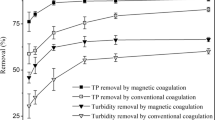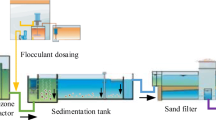Abstract
In this study, laboratory-scale magnetic flocculation systems were set up and the optimal coagulant and flocculent dosage, magnetic seed immersion, pH, stirring intensity, and precipitation time were all evaluated. A total of 729 expansion reaction conditions were generated, and 700 of the expansion reaction conditions were used to train a back-propagation neural network (BPNN) and general regression neural network (GRNN). The other 29 conditions were used to verify the networks’ regression ability. The optimum coagulant was poly-aluminum chloride at a dosage of 100 mg/L; the optimum flocculent was anionic polyacrylamide at a dosage of 4 mg/L; the optimum size of the magnetic seed was 200 mesh at a dosage of 1 g/L; and the optimum stirring intensities were 300 r/min for the coagulation tank, 200 r/min for the mixing tank, and 100 r/min for the flocculation tank. Comparing BPNN and GRNN, the GRNN’s regression performance better matched the relationship between the reaction conditions and results.
Zusammenfassung
In dieser Studie wurden magnetische Flockungssysteme im Labormaßstab eingerichtet. Als Prüfbedingungen wurden die Dosierung des Fällungs-mittels, des Flockungsmittels, der pH-Wert der Lösung mit den magnetischen Trägerpartikeln, die Rührintensität und die Fällungszeit ausgewählt. Basierend auf einzelnen Werten dieser Prüfbedingungen wurden insgesamt 729 Versuchsbedingungen erzeugt. Für das Training der Neuronalen Netze (Fehlerfortpflanzungsnetzwerk – BPNN und Regressions¬netzwerk – GRNN) wurden 700 Versuchsbedingungen verwendet. Die übrigen 29 Versuchsbedingungen wurden zur Überprüfung der Eignung der neuronalen Netze genutzt. Folgende optimale Werte der Prüfparameter wurden ermittelt: Polyaluminiumchlorid (PAC) als Fällungsmittel mit einer Dosierung von 100 mg/L; anionische Polyacrylamide (PAM) als Flockungsmittel mit einer Dosierung von 4 mg/L; eine Gitterweite von 200 Maschen für die magnetischen Trägerpartikel und einer Dosierung von 1 g/L sowie eine Rühr¬geschwindigkeit von 300 U/min für den Fällungsreaktor, 200 U/min für den Mischungsreaktor und 100 U/min für den Flockungsbehälter. Zur Ermittlung der optimalen Parameter zeigte das GRNN von den neuronalen Netzen BPNN und GRNN eine bessere Regression im Vergleich zwischen den Versuchsbedingungen und den Überwachungsindezes.
Resumen
En este estudio, se establecieron sistemas de floculación magnética a escala de laboratorio y se seleccionaron las dosis de coagulante, la dosis de floculante, el pH de inmersión de la semilla magnética, la intensidad de agitación y el tiempo de precipitación como condiciones de inspección para determinar ciertos niveles. Sobre la base de ciertos niveles, se generaron un total de 729 condiciones de reacción de expansión y se utilizaron 700 de las condiciones de reacción de expansión para entrenar la red neuronal de propagación hacia atrás (BPNN) y la red neuronal de regresión general (GRNN). Las otras 29 condiciones se utilizaron para verificar la capacidad de regresión de la red. El coagulante óptimo fue policloruro de aluminio (PAC) y la dosis fue de 100 mg/L, el floculante óptimo fue poliacrilamida aniónica (PAM aniónica) y la dosis fue de 4 mg/L, el tamaño óptimo de la semilla magnética fue de 200 mesh y la dosis fue de 1 g/L, las velocidades de agitación óptimas fueron 300 rpm para el tanque de coagulación, 200 rpm para el tanque mixto y 100 rpm para el tanque de floculación. Para los parámetros óptimos de BPNN y GRNN, GRNN tuvo un mejor rendimiento de regresión al hacer coincidir la relación entre las condiciones de reacción y el índice de monitoreo.
抽象
建立了室内磁絮凝系统,观察并确定了凝结剂投加量、絮凝剂投加量、磁种浸泡pH值、搅拌强度和沉淀时间的工况水平。基于该工况水平,生成了729种扩展反应条件,以其中700个扩展反应条件训练反向传播神经网络模型(BPNN)和广义回归神经网络(GRNN)模型,再用剩余29个扩展条件检验网络模型的回归分析能力。最佳凝结剂为无机混凝聚合氯化铝(PAC),投加量为100mg/L;最佳絮凝剂为阴离子-聚丙烯酰胺(阴离子-PAM),投加量为4mg/L;最佳磁种粒径为200目,投加量为1g/L;最佳搅拌强度是混凝池300r/min、混合池200r/min和絮凝池100r/min。对比BPNN和GRNN的最佳模型参数,GRNN拥有更好的反应条件与监测指标匹配的回归性能。














Similar content being viewed by others
References
Almeida JS (2002) Predictive non-linear modeling of complex data by artificial neural networks. Curr Opin Biotech 13(1):72–76
Gao L, Connor J, Doble R, Ali R, McFarlane D (2013) Opportunity for peri-urban Perth groundwater trade. J Hydrol 496:89–99
Guclu D, Dursun S (2010) Artificial neural network modelling of a large-scale wastewater treatment plant operation. Bioprocess Biosyst Eng 33(9):1051–1058
Hong SH, Lee MW, Lee DS (2007) Monitoring of sequencing batch reactor for nitrogen and phosphorus removal using neural networks. Biochem Eng J 35(3):365–370
Hush D, Horne B (1993) Progress in supervised neural networks. IEEE Signal Proc Mag 10(1):8–39
Kirby M, Connor JD, Ahmad M, Gao L, Mainuddin M (2014) Climate change and environmental water reallocation in the Murraye-Darling Basin: impacts on flows, diversions and economic returns to irrigation. J Hydrol 518(2):120–129
Kirby M, Connor JD, Ahmad M, Gao L, Mainuddin M (2015) Irrigator and environmental water management adaptation to climate change and water reallocation in the Murraye-Darling Basin. Water Econ Policy 01(03):155–199
Li YR, Wang J, Zhao Y, Luan ZK (2010) Research on magnetic seeding flocculation for arsenic removal by superconducting magnetic separation. Sep Purif Technol 73(2):264–270
Mehra P, Wah BW (1992) Artificial neural networks. In: Wah BW (ed) Artificial neural networks: concepts and theory, 1st edn. IEEE Computer Society Press, Los Alamitos, pp 1–12
Nazari J, Ersoy O (1992) ECE technical reports. School of Electrical Engineering Purdue University, Indiana, USA. https://docs.lib.purdue.edu/cgi/viewcontent.cgi?article=1279&context=ecetr
Pavlova S, Dobrevsky I (2005) Modified Sirofloc process for natural water treatment. Desalination 173(1):55–59
Pendashteh A, Fakhru’l-Razi A, Chaibakhsh N, Abdullah LC, Madaeni SS, Abidin ZZ (2011) Modeling of membrane bioreactor treating hypersaline oily wastewater by artificial neural network. J Hazard Mater 192(2):568–575
Speacht DF (1991) A general regression neural networks. IEEE T Neural Networ 2(6):568–576
Sprecht DF (1993) The general regression neural network-rediscovered. Neural Networks 6(7):1033–1034
Tsouris C, Scott TC (1995) Flocculation of paramagnetic particles in a magnetic field. J Colloid Interf Sci 171(2):319–330
Wang WP, Gao L, Liu P, Hailu A (2014) Relationships between regional economic sectors and water use in a water-scarce area in China: a quantitative analysis. J Hydrol 515(13):180–190
Yiacoumi S, Rountree DA, Tsouris C (1996) Mechanism of particle flocculation by magnetic seeding. J Colloid Interf Sci 184(2):477–488
Zhao Y, Liang WY, Liu LJ, Li FZ, Fan QL, Sun XL (2015) Harvesting Chlorella vulgaris by magnetic flocculation using Fe3O4 coating with polyaluminium chloride and polyacrylamide. Bioresource Technol 198:789–796
Acknowledgements
This work was supported by the Natural Science Foundation of Hebei Province (Grant 15274006D).
Author information
Authors and Affiliations
Corresponding author
Electronic supplementary material
Below is the link to the electronic supplementary material.
Rights and permissions
About this article
Cite this article
Zhang, X., He, X., Wei, M. et al. Magnetic Flocculation Treatment of Coal Mine Water and a Comparison of Water Quality Prediction Algorithms. Mine Water Environ 38, 391–401 (2019). https://doi.org/10.1007/s10230-019-00590-9
Received:
Accepted:
Published:
Issue Date:
DOI: https://doi.org/10.1007/s10230-019-00590-9




